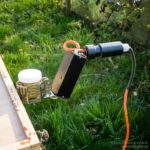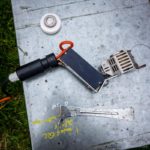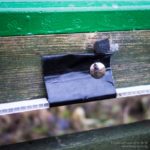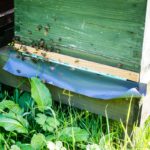If Carlsberg did vaporisers ...
… they’d make the Sublimox sublimator.
I wonder how many beekeepers have one of these on their wish list for Santa?
From being a bit of an imported oddity (I had to import mine from Icko Apiculture in France three years ago) they’re now becoming mainstream … over the last year or so they’ve been sold by an independent importer, then Abelo and – just this month – the ‘Big Daddy’ of UK beekeeping suppliers, E. M. Thorne (Rebecca at Thorne’s kindly asked if they could include links in their December newsletter to previous posts here on the Sublimox and vaporising Api-Bioxal).
The Sublimox is also now being discussed more widely on the online forums, with much of this discussion emphasising the price (they are expensive). Aside from this disadvantage, I think there are a number of significant advantages of this design of sublimator (vaporiser) which are worth emphasising.
The general principle of active and passive sublimators
Sublimators (vaporisers) are designed to heat oxalic acid (OA) crystals sufficiently that they sublimate i.e. go through a phase transition from a solid into a gas without an intervening liquid phase. As readers of this site should know, oxalic acid is highly effective against the Varroa mite – both by sublimation and trickling in solution, which has recently been covered in excruciating detail so won’t be elaborated on here.
Many sublimators (vaporisers) are passive. You add the OA to a pan, slide it into the hive entrance, apply a current to heat the pan, allow the OA to sublimate, withdraw the pan and start again. You usually need to cool the pan in water before addition of the next dose. This heat, rinse and repeat cycle takes time, but is very effective and the pan-type vaporisers are relatively inexpensive (£35-£100).
The Varrox vaporiser is one of the original and best known models, though there are any number of much less expensive copies sold by beekeeping suppliers and on eBay. Most require a 12V supply of some kind.
In contrast to these, the Sublimox is ‘active’, as is the US equivalent machine, the ProVap 110. In these the pan is pre-heated, the OA is ‘dropped’ into the pan in such a way that the vapour is generated in an enclosed space which it then escapes under pressure through a nozzle.
Probably the best sublimator in the world …
In terms of speed, convenience and ease of use I’d argue that the Sublimox is hard to beat.
Quick
Delivery of a single dose takes no more than 45 seconds from inserting the Sublimox nozzle into the hive. It’s appreciably faster than the pan-type passive sublimators. There’s a preliminary warming up period before use, as the machine reaches operating temperature. After that it’s simply treat, refill, treat, refill ad infinitum. The rate-limiting step is sealing the hive and refilling the small plastic ‘cartridge’ with OA.
For one person, a hive-a-minute is just about possible – if you have 10-20 closely spaced hives, sufficient entrance blocks and buy additional white plastic cartridges. But, to achieve this you’ll be rushing about like a mad thing and it’s not realistically achievable1.
But speed isn’t the major benefit.
Convenient
It’s convenient because you can ‘squirt’ the gas through a small hole in hive. You don’t need to open the hive and so it works with any hive type or entrance. My favoured kewl floors cannot be used with a sublimator that needs to be pushed through the entrance. Instead, all my hives have a neat 6mm hole drilled through the sidewall of the floor which is usually plugged with a small foam bung or twist of grass2. Vapour quickly permeates throughout the hive, ensuring all surfaces are reached.
The only exception are the all-poly hives, such as the garishly coloured Abelo’s I’ve been using for work this season. The nozzle of the Sublimox gets hot and melts polystyrene (been there, done that 🙁 ). With poly hives I usually use a simple shallow eke with a Sublimox nozzle-sized hole in one side. In this case you do need to remove the roof and crownboard, add the eke, replace the roof (upside down), treat and then close up the hive.
The alternative is to simply squirt the gas through the open entrance. This isn’t ideal as some of the gas will escape, potentially exposing the beekeeper and definitely not exposing the bees/mites. One way to avoid this loss of gas is to use a wooden block with a small hole through the middle held over the poly hive entrance.
It’s important to have a clear space into which the gas is ‘squirted’. If you don’t the OA tends to not permeate through the hive properly.
The Abelo hives have a hole in one face of the brood box. This is usually plugged. I think it’s intended as an upper entrance. I’ve yet to try poking the Sublimox nozzle through this hole to deliver the OA … this might not work as it may be too close to the frame, so impeding the spread of gas through the box. Time will tell†.
Safety considerations
There’s an additional benefit of the way the Sublimox is used. Operator exposure to OA should be minimised. The gas isn’t generated until the machine is inserted and inverted and takes no more than ~45s to deliver. If the hive is sealed properly there’s very little exposure to the gas.
… but all this comes at a cost
The Sublimox is three-times the price of a Varrox vaporiser. Is it worth it? That’s up to the purchaser to decide, based on the number of hives to be treated, the depth of their pockets, the perceived benefits of the speed, ease of use, convenience and safety etc.
Many will baulk at the cost. Some build their own. Others don’t bother vaporising, but solely dribble OA solution in midwinter. This is the cheapest and fastest way to treat colonies. I estimate it costs about 0.5p/hive to trickle treat if you buy OA in 25kg bags. Dribbling is probably even faster than using the Sublimox. However, dribbling is really only practical for broodless colonies – swarms and for midwinter use – and should only be done once per season. In contrast, repeated sublimation is tolerated well by colonies.
Would I buy another one?
Almost certainly.
Before you splash the cash
Be aware … the Sublimox requires a 240V supply. One of my apiaries has mains power which is the best solution, but unlikely in the corner of a farmers field. You can use an inverter from a car battery which is fine if you can get your car close enough to the hives. Alternatively – and this is what I do – you can use a portable generator. I’ve got an 700W Impax one from Screwfix which works perfectly.
But that’s another £190 🙁
You’ll also need to periodically buy replacement sealing rings for the OA “cassette”. These wear out or perish rather fast. Icko sell them for a daft price, but they’re now available in the UK.
You should also be aware that Api-Bioxal, the VMD-approved oxalic acid-containing miticide, has glucose in it which caramelises in the pan of the Sublimox (and other vaporisers) and is a bit of a nightmare to clean out properly. I’d go further and suggest that Api-Bioxal is unsuitable to use with a Sublimox. If the nozzle is blocked the gas has to escape and there could be inadvertent exposure of the operator.
Safety first
I’ve touched on safety above. However, just because OA vapour is generated for a very short and well defined time doesn’t make it safe. There are still exposure risks which must be taken seriously.
You’ll need PPE – personal protection equipment – to prevent exposure to the OA vapour when treating colonies. This includes eye protection and a suitable vapour mask. Don’t skimp on this and assume you’ll just stand downwind. If the hive is poorly sealed, swirling gusts of wind will expose you to vapour and it’s – at best – very, very unpleasant.
Unlike passive vaporisers, the Sublimox generates a very large volume of gas immediately the OA is added. There’s no opportunity to ‘stand well back’ as the pan warms up as you can with the passive machines. You have to be holding the Sublimox to invert it and drop the OA into the pan. You’ll be bent over the hive and unable to avoid the swirling fog of acidic vapour if it escapes. To help minimise this seal the hive thoroughly. I use a full-width entrance block and tightly fitting Varroa tray. Even then, particularly on ageing cedar hives, there are all sorts of little gaps from which the OA vapour can be seen escaping.
Finally, as if gassing yourself with an evil smelling acidic cloud of OA wasn’t enough, remember you’re using a 240V supply outside, probably on damp grass … or possibly even in the rain. Don’t get electrocuted. Make sure you use an RCD (residual current device) that’s been tested and you know works.
Take care.
Share the costs
At the time of writing the Sublimox costs over £300. Perhaps competition will force the price down a bit? When you consider that these machines are used relatively infrequently during the season it makes sense to consider purchasing them as an Association item (or with a group of friends), in the same way that some associations have extraction equipment available.
When compared to a reasonable extractor the Sublimox doesn’t seem so outrageously priced.
Of course, like an extractor, everyone needs it at about the same time of the season (at least in midwinter). However, unlike an extractor, it’s generally needed for a relatively short period, is easy to transport and easy clean after use. There should be no reason it couldn’t be shared by association members.
I appreciate that many associations don’t have shared equipment, or many beekeepers don’t belong to their local association. All I’m doing is suggesting a way in which a good quality and highly effective piece of equipment could be purchased so that many can benefit.
Whether you’ve got one of these on your list for Santa or not …
… Happy Christmas!
1 The rate-limiting step is probably having enough entrance blocks. If removed too soon you’ll lose lots of vaporised OA goodness. Leave it a good 5 minutes if at all possible, which is easily enough time to treat another 5 hives. See what I mean?
2 When treating a hive for the first time I’ve even drilled this hole through an occupied hive.
† Actually, this hole isn’t suitable. It opens onto the face (rather than end) of a frame, and the vapour is therefore restricting from spreading. Don’t bother.
‡ I’ve regularly treated colonies in the dark. Sometimes the only time I can get to the apiary is after work. The bees are all ‘at home’ but you can easily seal the hive up and treat them. Use a headtorch with a red bulb. Since bees can’t see red, any that escape won’t directly target your head and you can probably work safely without a veil.
Colophon
If Carlsberg did … is one of the most recognisable advertising campaigns of all time. Originally created in 1973 it has achieved near-universal recognition and remains in daily use, though predominantly these days as internet memes. The opening three words of the adverts were as recognisable as the closing seven … probably the best lager in the world.
There are any number of comedic If Carlsberg did ‘advertising’ campaigns, including some from Carlsberg itself … Probably the best poster in the world, featured the distinctive swirly underscore, colour scheme and font, together with a real tap dispensing lager installed in Londons Brick Lane.
Carlsberg revamped the advertising campaign in 2015 (the poster above was part of this), over 40 years after it was first used. You can view these adverts on the Carlsberg website.
I’ve used a variant of the If Carlsberg did … phrase previously, when describing the large Dadant smoker. It’s still a great smoker.









Join the discussion ...